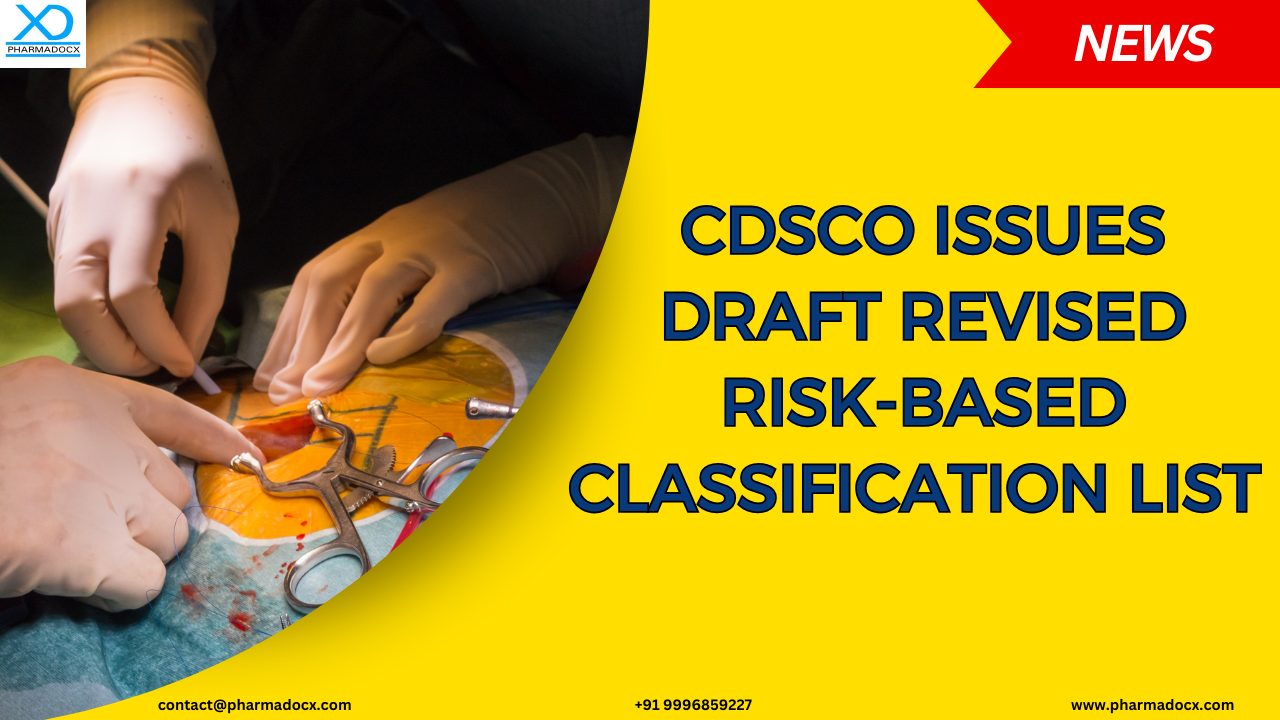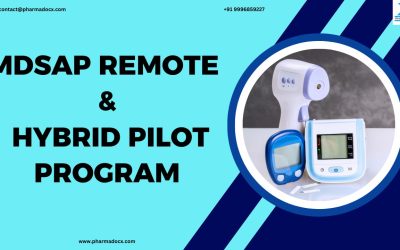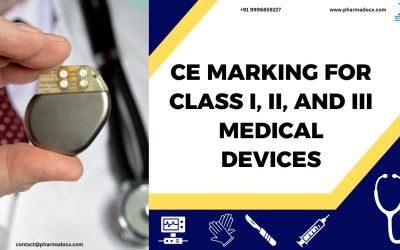Central Drugs Standard Control Organisation (CDSCO) is the apex regulatory body for medical devices, drugs, and cosmetics in India. The CDSCO works under the guidance of Medical Devices Rules (MDR), 2017. The Drug Controller General of India (DCGI) is the governing body of CDSCO. For ease of medical device registration and licensing purposes, the CDSCO has categorised medical devices into various classes. In a notice dated April 1, 2025, CDSCO has issued a revised risk-based classification list for cardiovascular and neurological devices. This a draft list covering 553 medical devices. Furthermore, industry stakeholders have been urged to submit their comments on the reclassification notice by the end of the month.
What is the CDSCO medical device classification system?
Based on certain parameters, such as risk level and intended use, medical devices are grouped into specific classes. The medical device classification helps determine the regulatory pathway and requirements for market authorization of medical devices in the country. The CDSCO has classified medical devices into the following four classes:
- CDSCO class A: Low-risk medical devices are grouped as class A.
- CDSCO class B: Low to moderate-risk medical devices are grouped as class B.
- CDSCO class C: Moderate to high-risk medical devices are grouped as class C.
- CDSCO class D: High-risk medical devices are grouped as class D.
The CDSCO medical device classification system is sorted from the lowest to the highest risk level. Currently, 24 categories of medical devices are classified into these four CDSCO classes. The CDSCO medical device class determines the license application pathway. The manufacturer can fill in the registration and licensing paper work depending on the medical device class.
CDSCO issues draft revised risk-based classification list for cardiovascular and neurological medical devices
The CDSCO has released a draft revised risk-based classification list for cardiovascular and neurological medical devices. The DCGI has stated the existing classification lists in the cardiovascular and neurological categories have been revised as per the First Schedule (Part 1) of the MDR, 2017. Furthermore, new entries have been added to the list.
The updated draft revised risk-based classification list includes a total of 553 devices. Among them, 351 are from the cardiovascular category and 202 belong to neurological category. Among the 553 devices listed in the reclassification draft, 221 devices have been placed under Class D. Furthermore, 153 devices have been placed under Class B, 151 devices under Class C, and 25 devices under Class A.
The medical device industry has welcomed this reclassification system. This revised risk-based classification would provide clarity for both regulatory authorities and manufacturers, especially during medical device license application submission. Moreover, clarity in regulatory guidelines will be beneficial for the medical device industry, as this will drive innovation. Furthermore, this will enhance patient safety and improve patient outcome. Thus, it will lead to improved market demand and growth of the industry.
Revised risk-based reclassification of cardiovascular medical devices
We have provided some examples of cardiovascular medical devices that have been reclassified.
| Device name | Intended use | Risk Class |
|---|---|---|
| Micro-catheter | It is intended to access the peripheral and neurovasculature for the controlled selective infusion of physician-specified therapeutic agents such as embolization materials and or diagnostic materials such as contrast media. | Class D |
| Mitral heart valve bioprosthesis | A xenograft (e.g., porcine or bovine heart valve) intended to be implanted in a patient during open heart surgery to repair or replace a dysfunctional mitral heart valve. | Class D |
| Intra-aortic balloon | An intra-aortic balloon is a prescription device that consists of an inflatable balloon, which is placed in the aorta to improve cardiovascular functioning during certain life-threatening emergencies, and a control system for regulating the inflation and deflation of the balloon. | Class C |
| His bundle detector | A device intended to detect disorders of impulse conduction in the bundle of His (atrioventricular) from the atrium to the cardiac ventricle. | Class C |
| Heart-lung bypass unit tube | A tube will be placed in your heart to drain blood to the machine. | Class C |
| Heart valve prosthesis holder | A surgical instrument intended to hold a cardiac (heart) valve prosthesis or a cardiac annuloplasty ring at, or in proximity to, its site of implantation during surgery. It includes an implant mounting/containing feature and a handle; implantable devices are not included. | Class A |
| Heart valve prosthesis tester, single-use | A pen-like device intended to be used to manually manipulate a heart valve prosthesis to perform an assessment of the valvular prosthesis (e.g., its ability to open and close) prior to implantation and/or when in situ. | Class C |
| Impedance cardiac output unit (Impedance cardiography) | A device intended to quantify cardiac output from measurements of the thoracic impedance changes associated with cardiac activity. | Class B |
| Impedance cardiograph | An electrocardiograph used to record variations in chest electric impedance generated by myocardial activity. | Class B |
| Carotid sinus nerve stimulator | A carotid sinus nerve stimulator is an implantable device used to decrease arterial pressure by stimulating Hering’s nerve at the carotid sinus. | Class D |
| Carotid filter system | Intended to be used while performing angioplasty and stenting procedures in carotid arteries. | Class D |
| Carotid artery shunt | It is intended to serve as a temporary blood conduit (a shunt) connecting the distal internal carotid artery to the proximal common carotid artery allowing intravascular blood to continuously flow to the patient’s brain during an endarterectomy procedure. | Class D |
| Cardiovascular embolization implantation kit | A collection of dedicated instruments intended to be used for the implantation of an embolization implant (implant not included). (e.g., needle, introducer, guidewires, catheter). | Class D |
| Cardiovascular implant implantation tool base | A sterile plate-like device intended to function as a sturdy support (base) for the holder/implantation tool of a cardiovascular implant (e.g., biologic-polymer aorta graft, heart valve bioprosthesis). | Class A |
| Apheresis Kit | Intended for the collection and separation of blood components | Class C |
| Arterial catheter | Intended to be used in conjunction with steerable guidewires in order to access discrete regions of the coronary and peripheral arterial vasculature. | Class D |
| Arterial cannula | Inserted into an artery, commonly the radial artery, and is used during major operations and in critical care areas to measure beatto-beat blood pressure and to draw repeated blood samples. | Class D |
| Wearable neonatal heart rate meter | An electrically-powered device intended to detect and display the heart rate of a neonate, typically within the first few hours after delivery. | Class B |
| Vessel dilator for percutaneous catheterization | A vessel dilator for percutaneous catheterization is a device which is placed over the guide wire to enlarge the opening in the vessel, and which is then removed before sliding the catheter over the guide wire. | Class C |
| Ventricular bypass (assist) device | A ventricular bypass (assist) device is a device that assists the left or right ventricle in maintaining circulatory blood flow. The device is either totally or partially implanted in the body. | Class D |
Revised risk-based reclassification of neurological medical devices
We have provided some examples of neurological medical devices that have been reclassified.
| Device name | Intended use | Risk Class |
|---|---|---|
| Aneurysm clip | An aneurysm clip is a device used to occlude an intracranial aneurysm (a balloonlike sac formed on a blood vessel) to prevent it from bleeding or bursting. | Class D |
| Antibiotic impregnated Hydrocephalous Catheter | It is intended for use in the treatment of hydrocephalous as a component of a shunt system when draining or shunting of cerebrospinal fluid (CSF) is indicated. | Class D |
| Brain-responsive electrical stimulation system | Intended to continuously monitor brain activity and deliver electrical stimuli to seizure foci in response to neurological disorders (e.g., epilepsy). | Class D |
| Cardiac-therapy vagus nerve electrical stimulation system | Intended to apply periodic stimuli to the vagus nerve as a treatment for cardiac failure. | Class D |
| Cerebral oximeter sensor, single use | A photoelectric device designed to be applied externally to the scalp/head of a patient for transcutaneous measurement [e.g., using nearinfrared spectroscopy (NIRS)] of brain tissue blood oxygen saturation and/or venous oxygen saturation in the brain. | Class C |
| Cerebrospinal fluid manometer | Intended to measure the cerebrospinal fluid (CSF) pressure/intracranial pressure via lumbar puncture. | Class C |
| Cerebrospinal fluid shunt adaptor | A sterile device intended to enable connection of a cerebrospinal fluid (CSF) shunt or shunt component (e.g., cerebrospinal fluid catheter) to a syringe during shunt patency checking; it is not intended to be implanted. | Class B |
| Cranial bur | Intended to fit into an appropriate powered handpiece that provides the rotation allowing the user to excavate soft or hard skull tissue. | Class B |
| Cranial electrotherapy stimulator | A cranial electrotherapy stimulator is a device that applies electrical current to a patient’s head to treat insomnia, depression, or anxiety | Class D |
| Cranial trephine | Intended as a neurosurgical blade used to cut/remove circular sections of the skull vault (calvarium) to provide access to the interior. | Class B |
| Vagus nerve electrical stimulation system programmer | It is intended to program the strength and duration of the electrical impulses for a vagus nerve electrical stimulation system. | Class C |
| Ventriculo-peritoneal/atrial shunt | An implantable device intended to divert excessive cerebrospinal fluid (CSF) from the brain ventricles to either the peritoneal cavity or the heart right atrium (i.e., dual-capability), where it can be absorbed into the body, as a treatment for increased intracranial pressure (e.g., caused by hydrocephalus). Disposable devices associated with implantation may be included. | Class D |
| Skullplate screwdriver, reusable | It is intended to be used to fasten cranioplasty plates or skull plates to a patient’s skull by screws. | Class A |
| Spinal shaver system handpiece | A power-driven hand-held device used as a component of a shaver system which is used for the removal of bone/brawn/cartilage during spinal surgery. | Class B |
| Spinal shaver system blade | A cutting device designed for use in a powered spinal decompression shaver system handpiece (not included) for bone and soft-tissue resection during spinal surgery. | Class B |
| Spinal shaver system | A hand-held powered surgical instrument intended for bone and soft tissue resection during spinal surgery | Class B |
| Tibial nerve percutaneous incontinence-control electrical stimulation system | Intended to treat urinary and/or faecal incontinence with electrical stimuli applied to the sacral nerve via percutaneous tibial nerve stimulation (PTNS). | Class C |
| Transcranial magnetic stimulation system | An assembly of electrically-powered devices intended for the treatment and/or diagnosis of neurological, psychiatric and/or cognitive conditions (e.g., Alzheimer’s disease, major depressive disorder, pain) through noninvasive magnetic stimulation of the brain and/or peripheral nerves. | Class C |
| Vagus nerve electrical stimulation system programmer | It is intended to program the strength and duration of the electrical impulses for a vagus nerve electrical stimulation system. | Class C |
| Transvenous phrenic nerve electrical stimulation control unit | Intended to configure/deliver stimulation of the phrenic nerve, via a transvenous electrode, to cause contraction of the diaphragm in conjunction with mechanical ventilation to assist earlier ventilation weaning. | Class D |
Option to submit feedback regarding the revised risk-based classification list
The revised risk-based classification list released is a draft and CDSCO has provided the option to submit feedback. CDSCO has asked the industry and other concerned stakeholders to submit their feedback and comments on the draft within 30 days of issues of this notice. Stakeholders are urged to use the Google form attached along with the notice to submit their feedback within the stipulated deadline.
We at Pharmadocx Consultants will be more than happy to help you navigate CDSCO’s regulatory complexities. For any queries regarding the newly released draft risk-based classification list, drop an email at [email protected] or call/Whatsapp on 9996859227.





